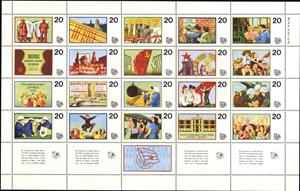Mini Sheet: From becoming and growing our friendship (Cinderellas 1979)
From becoming and growing our friendship (Cinderellas 1979)
01 January (Cinderellas ) within release German-Soviet Friendship (DSF) goes into circulation Mini Sheet From becoming and growing our friendship face value 20 East German pfennig
| Mini Sheet From becoming and growing our friendship in catalogues | |
|---|---|
| Colnect codes: | Col: DD 1979-01 |
Mini Sheet is square format.
Stamps from the booklet "From becoming and growing our friendship".Also in the issue German-Soviet Friendship (DSF):
- Stamp - 1917 face value 20;
- Stamp - Army face value 20;
- Stamp - Book face value 20;
- Stamp - Celebration face value 20;
- Stamp - Celebration face value 20;
- Stamp - Complex Programs face value 20;
- Stamp - Constitution of the GDR face value 20;
- Stamp - Dance face value 20;
- Stamp - Emblem face value 20;
- Stamp - Flag face value 20;
- Stamp - Freedom for the Pelman! face value 20;
- Stamp - Friendship GDR 30 face value 20;
- Mini Sheet - From becoming and growing our friendship face value 20;
- Stamp - Newspapers face value 20;
- Stamp - Pioneers face value 20;
- Stamp - Posting posters face value 20;
- Stamp - Sõrmus the red violinist in berlin face value 20;
- Stamp - Train Platform face value 20;
- Stamp - Workers face value 20;
- Stamp - Workers face value 20;
- Stamp - Workers face value 20;
Mini Sheet From becoming and growing our friendship it reflects the thematic directions:
A building or edifice is a structure with a roof and walls standing more or less permanently in one place, such as a house or factory. Buildings come in a variety of sizes, shapes and functions, and have been adapted throughout history for a wide number of factors, from building materials available, to weather conditions, to land prices, ground conditions, specific uses and aesthetic reasons. Buildings serve several needs of society – primarily as shelter from weather, security, living space, privacy, to store belongings, and to comfortably live and work. A building as a shelter represents a physical division of the human habitat (a place of comfort and safety) and the outside (a place that at times may be harsh and harmful).
Biologically, a child (plural: children) is a human being between the stages of birth and puberty. The legal definition of child generally refers to a minor, otherwise known as a person younger than the age of majority. Child may also describe a relationship with a parent (such as sons and daughters of any age) or, metaphorically, an authority figure, or signify group membership in a clan, tribe, or religion; it can also signify being strongly affected by a specific time, place, or circumstance, as in "a child of nature" or "a child of the Sixties". There are many social issues that affect children, such as childhood education, bullying, child poverty, dysfunctional families, child labor, hunger, and child homelessness. Children can be raised by parents, by fosterers, guardians or partially raised in a day care center.
A festival is an event celebrated by a community and centering on some characteristic aspect or aspects of that community and its religion or cultures. It is often marked as a local or national holiday, mela, or eid. A festival constitutes typical cases of glocalization, as well as the high culture-low culture interrelationship. Next to religion and folklore, a significant origin is agricultural. Food is such a vital resource that many festivals are associated with harvest time. Religious commemoration and thanksgiving for good harvests are blended in events that take place in autumn, such as Halloween in the northern hemisphere and Easter in the southern.
A flag is a piece of fabric (most often rectangular or quadrilateral) with a distinctive design that is used as a symbol, as a signaling device, or as decoration. The term flag is also used to refer to the graphic design employed, and flags have since evolved into a general tool for rudimentary signalling and identification, especially in environments where communication is similarly challenging (such as the maritime environment where semaphore is used). National flags are patriotic symbols with varied wide-ranging interpretations, often including strong military associations due to their original and ongoing military uses. Flags are also used in messaging, advertising, or for other decorative purposes. The study of flags is known as vexillology, from the Latin word vexillum, meaning flag or banner.
A people is a plurality of persons considered as a whole, as is the case with an ethnic group or nation. Collectively, for example, the contemporary Frisians and Danes are two related Germanic peoples, while various Middle Eastern ethnic groups are often linguistically categorized as Semitic peoples.
A profession is a field of work that has been successfully professionalized. It can be defined as a disciplined group of individuals, professionals, who adhere to ethical standards and who hold themselves out as, and are accepted by the public as possessing special knowledge and skills in a widely recognised body of learning derived from research, education and training at a high level, and who are prepared to apply this knowledge and exercise these skills in the interest of others





